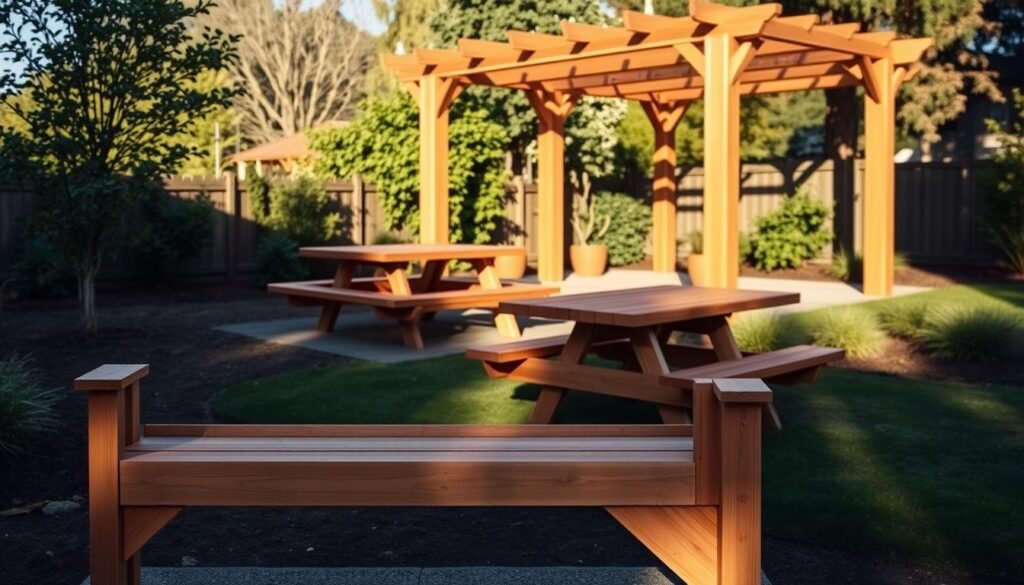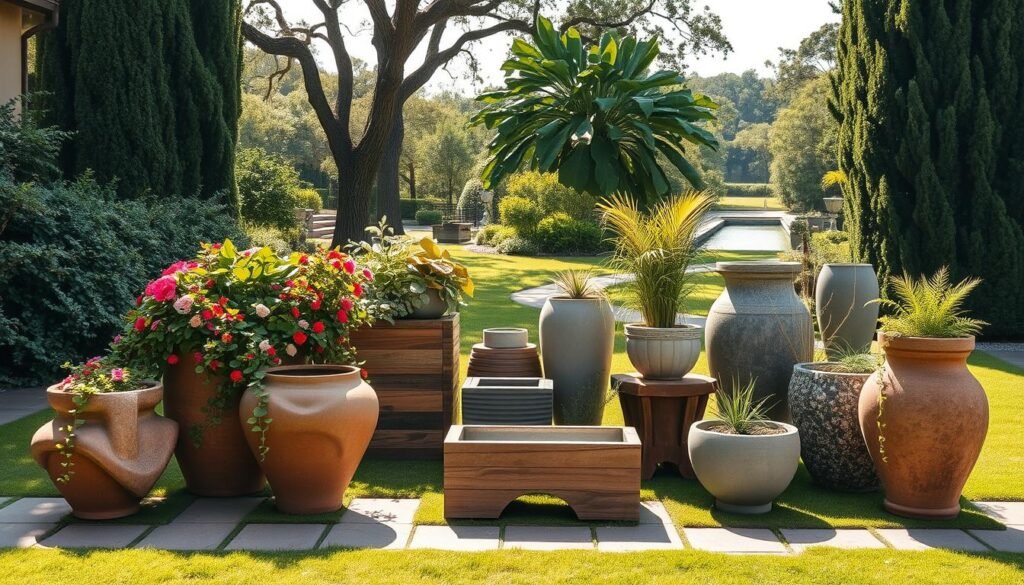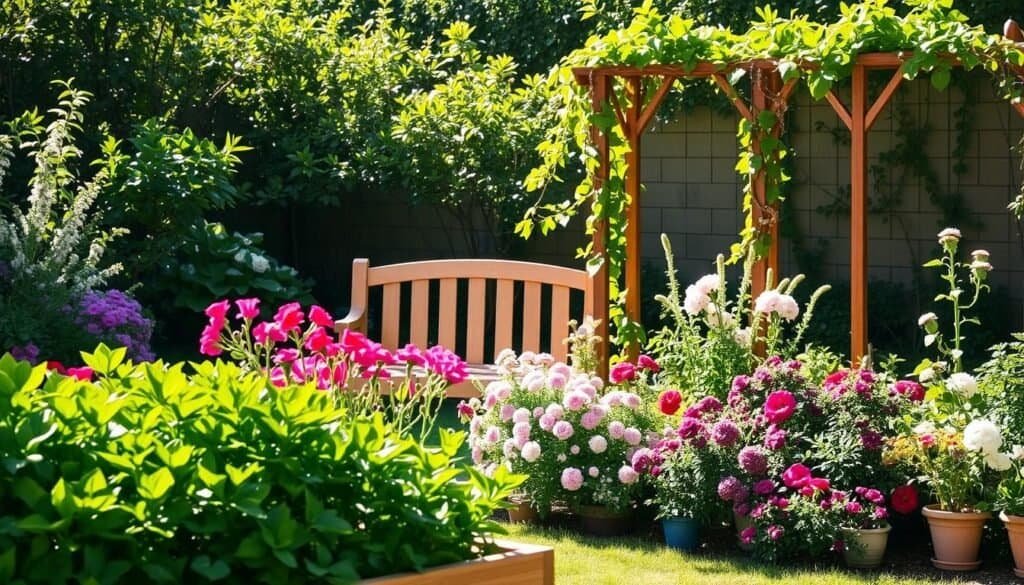Turning your backyard into a peaceful oasis is simpler than you might think. A great way to do this is by using DIY wooden planters.
These planters bring natural beauty to your outdoor area. They also let you show off your personal style. Adding wooden planters makes your backyard warm and welcoming, ideal for chilling out or hosting guests.
DIY wooden planters can make your outdoor area lively and connected to your home. They’re perfect for adding plants or making a bold statement. Wooden planters are both versatile and stylish.
The Transformative Power of Wooden Planters in Outdoor Spaces
Outdoor spaces become more inviting with wooden planters. They mix nature with decor beautifully. Wooden planters are more than just plant holders; they change the feel of outdoor areas.
Natural Integration with Landscape
Wooden planters fit right into the landscape with their natural charm. The wood’s texture matches the plants and other natural elements. This creates a perfect balance.
Whether it’s a rustic or polished planter, wood enhances outdoor decor. Cedar wood planters, for example, are durable and add a warm color to spaces.
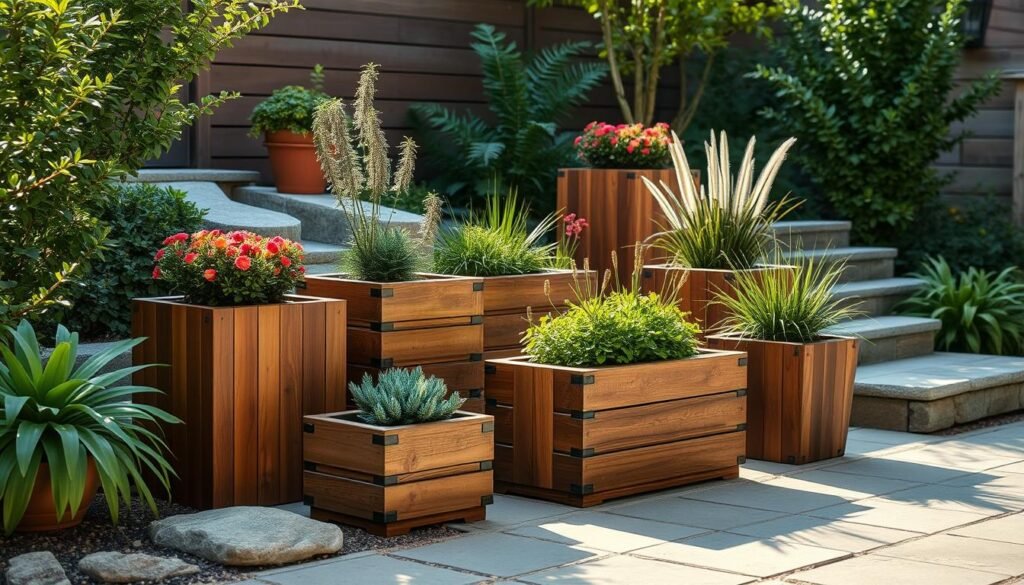
Choosing wooden planters is also good for the environment. Wood is renewable and can be sourced responsibly. This makes wooden planters an eco-friendly choice.
Wooden planters can also be recycled or repurposed, reducing waste. Their beauty and sustainability make them a top pick for green outdoor spaces.
Adding wooden planters to your outdoor decor boosts its look and supports the environment. They work well with many decor styles, from modern to rustic. This makes them a great choice for outdoor spaces.
Essential Materials for DIY Wooden Planter Projects
Choosing the right wood for your DIY planter projects is key. It affects both how well they work and how they look. The wood you pick can change how durable and attractive your planters are.
Cedar and redwood are top picks for DIY planters. They resist rot and insects well. This makes them great for outdoor use, handling different weather.
Cedar and Redwood Options
Cedar is a strong and flexible wood for outdoor projects. Its natural oils protect it from decay and bugs. This makes cedar a top choice for planters facing the outdoors.
Redwood, with its beautiful grain and toughness, is also a good option. It fights off rot and insects, though it might cost more than cedar.
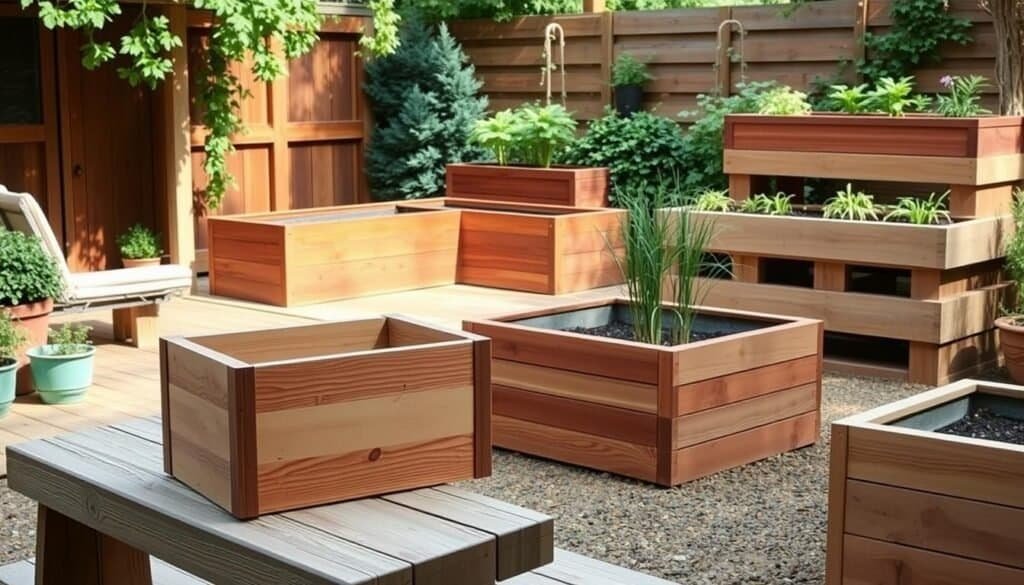
If you’re watching your budget, consider pressure-treated wood. It’s treated to fight rot and bugs, making it good for outside.
But, pressure-treated wood might not look as good as cedar or redwood. It also needs careful handling and safety steps when building.
So, what wood to choose depends on your budget, what you want it to look like, and how long you want it to last. Picking the right wood lets you make planters that are both beautiful and last a long time, improving your outdoor area.
Basic Woodworking Skills for Successful Planter Projects
To do well with planter projects, knowing the basics of woodworking is key. It doesn’t matter if you’re experienced or just starting out. Learning the fundamentals will make your projects more fun and fulfilling.
Measuring right is the first thing to do in any woodworking task. Use a tape measure and make sure your numbers are correct. This avoids big mistakes. Cutting wood properly is also vital; the right saw for the job makes a big difference in your planter’s quality.
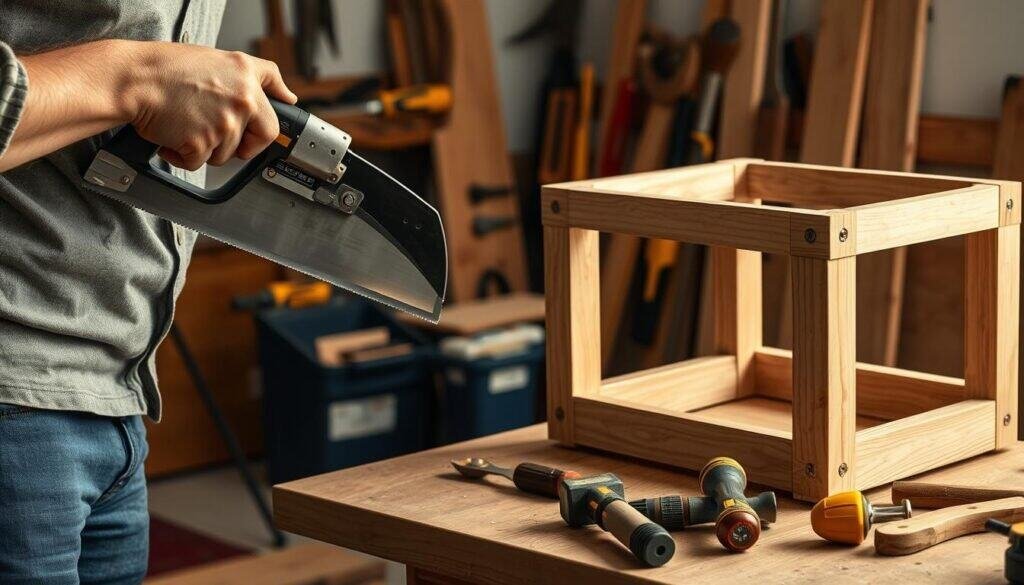
Putting the pieces together needs patience and carefulness. Pre-drilling for screws helps avoid wood splitting. Wood glue adds strength to your joints. Sanding smooths out any rough spots before you finish it.
Mastering these basic skills will help you make stunning and useful planters. With more practice, you’ll feel more confident in your DIY skills. Your outdoor area will look great with your own wooden planters.
Simple Box Planter: A Perfect Starter Project
Starting with woodworking? A simple box planter is a great first project. It helps you learn basic skills and creates something nice for your outdoor area.
Building the Base
The base of your planter is its foundation. Cut a piece of wood to the right size. Make sure it’s strong enough to hold the planter’s contents.
Use a level to make sure the base is even. This keeps your planter stable and prevents it from tilting.
Attach the base to the sides with screws or nails. Make sure they’re tight for the planter’s stability.
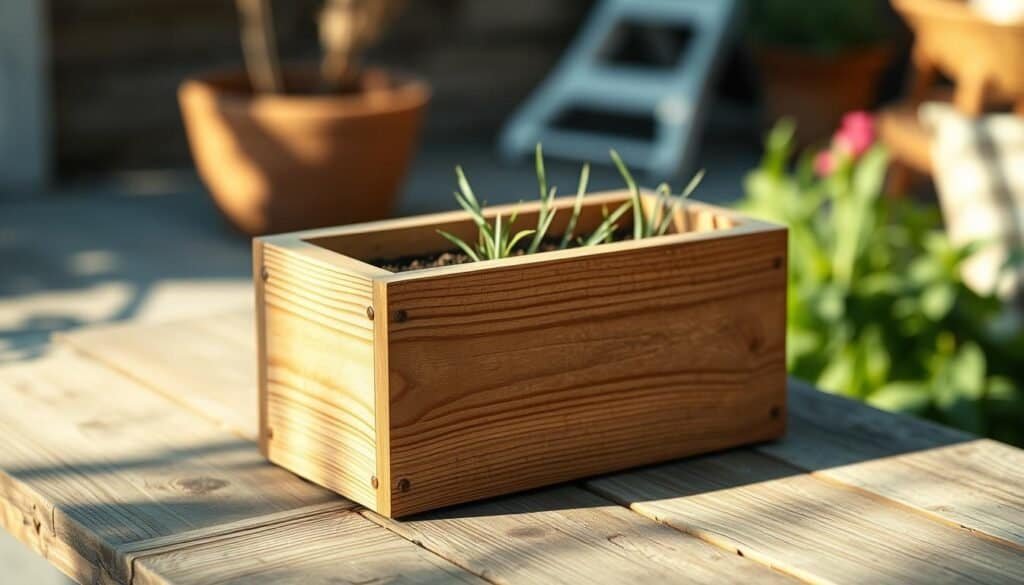
Now, build the sides of your planter. Cut four pieces of wood to the same height. Assemble them by attaching them to the base and each other at the corners.
For clean cuts, use a miter saw or a hand saw. Sand the edges to make them smooth. This will make your planter look good in your garden or patio.
When you’re done, think about adding a finish or sealant. It protects the wood from the weather. This keeps your planter looking good for a long time.
Tiered Wooden Planters for Vertical Interest
Tiered wooden planters add depth and interest to your outdoor space. They create a lush, layered look that draws the eye upward. This makes the most of your garden or patio’s vertical space.
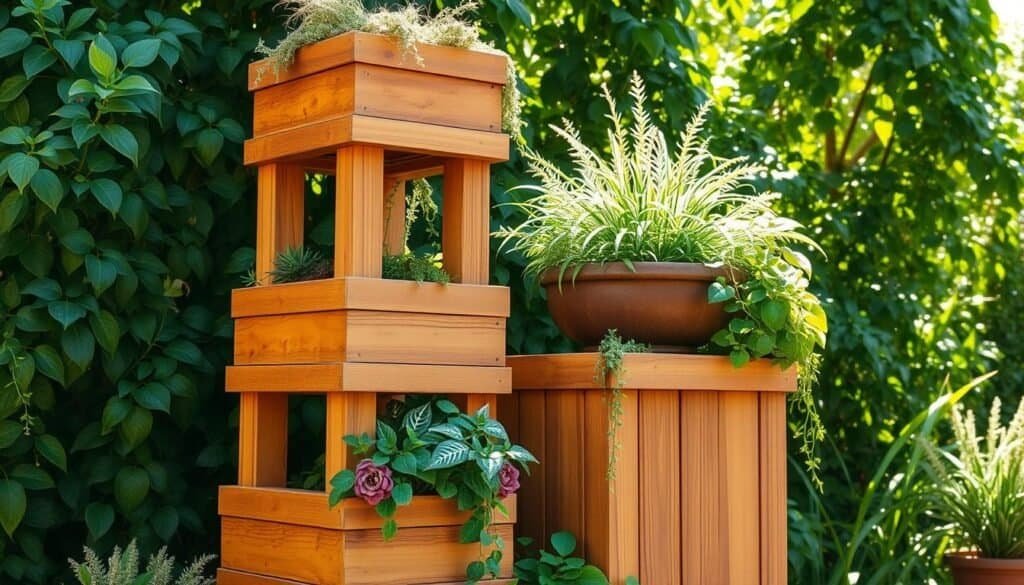
These planters are great for showing off different plants at various heights. This adds complexity and beauty to your garden design. When designing, think about both looks and function.
Creating Stable Tiers
To keep your planter stable, start with a sturdy base. Use wide, heavy planters at the bottom and secure each level. High-quality wood and strong construction help too.
Think about the plants’ mature size when building. This helps you choose the right size and spacing for each tier. This way, your planter will stay balanced and look good over time.
Ensuring Proper Drainage
Good drainage is key for your plants’ health and your planters’ life. Make sure to add drainage holes in each tier’s bottom. You can also put gravel or broken pottery at the bottom to help with drainage.
With careful planning, your tiered wooden planter will be both beautiful and useful. It will have stable tiers and good drainage. Your plants will thrive, and your planter will be a stunning display for years.
Outdoor Home Decor Ideas with DIY Wooden Planters
Make your outdoor area warm and unique with DIY wooden planters. These planters are great for seasonal displays. They keep your outdoor decor lively all year.
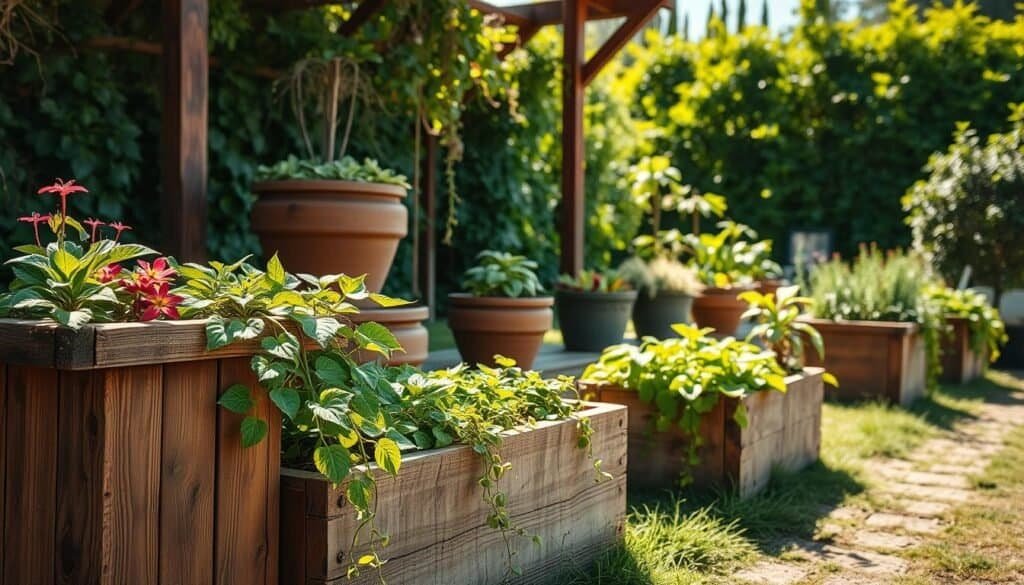
In spring and summer, fill your planters with bright flowers and greenery. Use a mix of annuals and perennials like petunias and ferns. Place taller plants in the back and cascading ones in the front for a nice look.
For a rustic feel, add pinecones, branches, and river rocks. Decorative accents like seashells can also enhance your planters.
Fall and Winter Arrangements
Update your planters for fall and winter with warm, cozy displays. Mix evergreen branches, pinecones, and holly for a festive look. Add seasonal flowers like mums for color.
For a winter theme, use snow-white pinecones and frosted glass ornaments. Add candles or fairy lights for a cozy glow on cold nights.
Changing your DIY wooden planter displays with the seasons keeps your decor fresh. With creativity, your outdoor space can be a beautiful, inviting oasis that shows off your style.
Upcycled Pallet Planters: Sustainable and Stylish
Give your garden a rustic touch with upcycled pallet planters. They are a perfect mix of eco-friendliness and style. Turning old pallets into planters not only cuts down on waste but also brings a unique charm to your outdoor area.
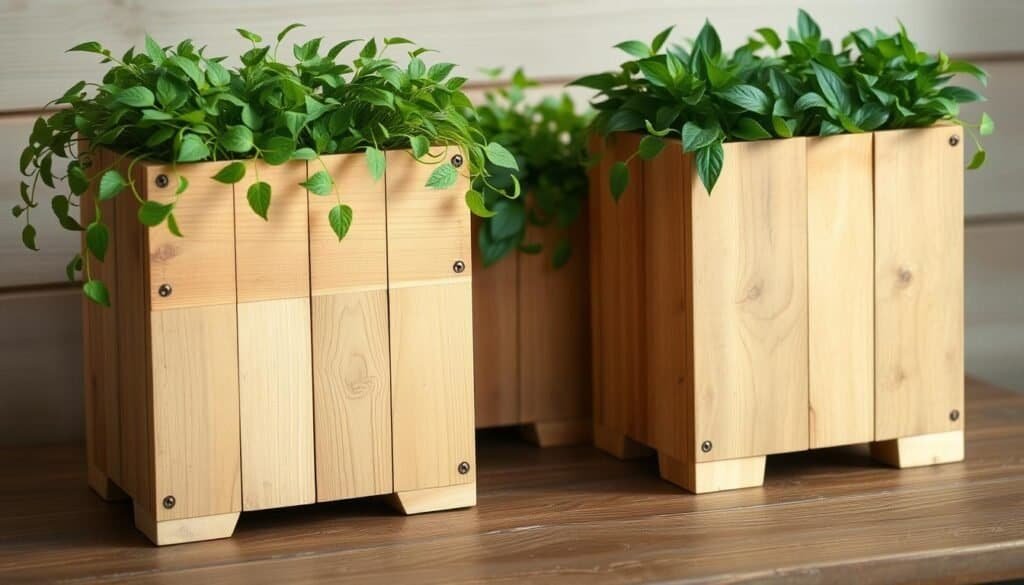
When working with reclaimed wood from pallets, safety is key. The wood might have been treated with chemicals or have splinters and nails that can hurt you.
Safety Considerations for Reclaimed Wood
Before starting, check the pallets for chemical treatment or damage. Wear gloves and safety glasses to avoid injuries from splinters or nails.
Disassembly Techniques
To take apart pallets, you’ll need a hammer, pry bar, and saw. Remove the nails or screws carefully, trying to keep as much wood as you can for your planter.
Upcycled pallet planters are not just good for the planet but also open up a world of creativity. You can adjust the size, shape, and finish to match your garden’s look, making each planter a piece of art.
By picking upcycled pallet planters, you’re helping the environment and making your outdoor space more stylish and eco-friendly.
Rustic Wooden Barrel Planters
Wooden barrels make great planters for your outdoor space. They add a rustic charm that brings the countryside to your garden or yard.
These planters are not just pretty. They’re also practical for showing off your plants. You can put flowers, herbs, small trees, or succulents in them. They fit right in with your outdoor decor.
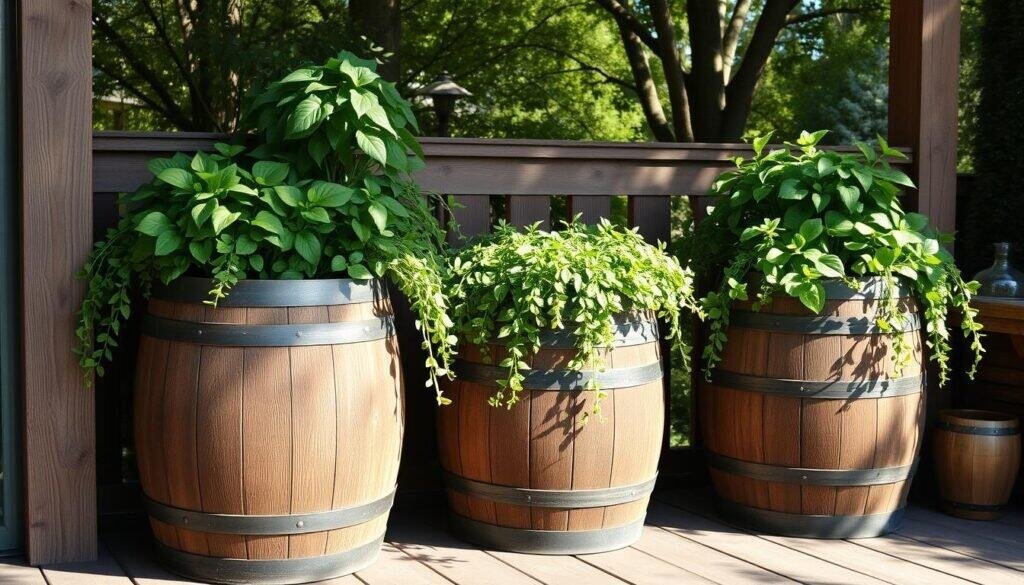
To keep your planters looking good, use a natural sealant. Check them often for damage and reapply sealant when needed. This keeps the wood in great shape.
Wooden barrel planters are perfect for adding a rustic feel to your garden. Or, they’re a fun DIY project. With some creativity, you can turn old barrels into beautiful planters that beautify your outdoor area.
Modern Geometric Wooden Planters
Modern geometric wooden planters are a great choice for fresh outdoor decor. They bring a contemporary style to your garden or patio. Plus, they offer a unique way to show off your plants.
Making these planters requires precision and detail, like perfect corners. Miter cuts are key to achieving this.
Miter Cuts for Perfect Corners
Miter cuts are angled cuts for corners. For a 90-degree corner, cut each piece at 45 degrees. This method is vital for smooth joints in your planters.
To get precise cuts, use a miter saw or a miter box with a hand saw. Accurate cuts mean clean, professional corners.
Assembly Methods for Geometric Shapes
Assembling your planter depends on its shape. For instance, a hexagonal planter needs careful planning for perfect fit.
Use wood glue and nails or screws to hold the pieces together. Clamping while the glue dries helps create a strong bond.
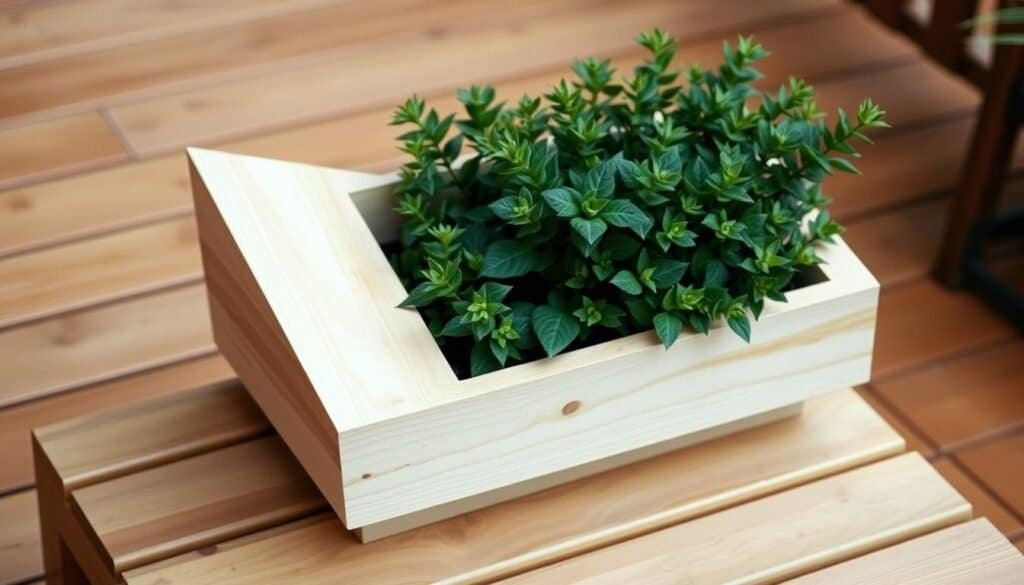
Modern geometric wooden planters can elevate your outdoor decor. Learning miter cuts and assembly for different shapes lets you make unique, stylish planters. These enhance your modern decor.
Whether you’re an experienced woodworker or a DIY beginner, these projects are a chance to learn new skills. You’ll create beautiful, useful pieces for your home.
Hanging Wooden Planters for Vertical Gardens
Creating a vertical garden with hanging wooden planters can change your outdoor decor. By hanging planters from a strong structure, you add layers of greenery and flowers. This makes your outdoor space more beautiful.
When picking plants for your hanging wooden planters, think about what works best in your outdoor area. For sunny spots, choose flowering plants or herbs. For shadier areas, ferns or ivy can bring a lush, green look.
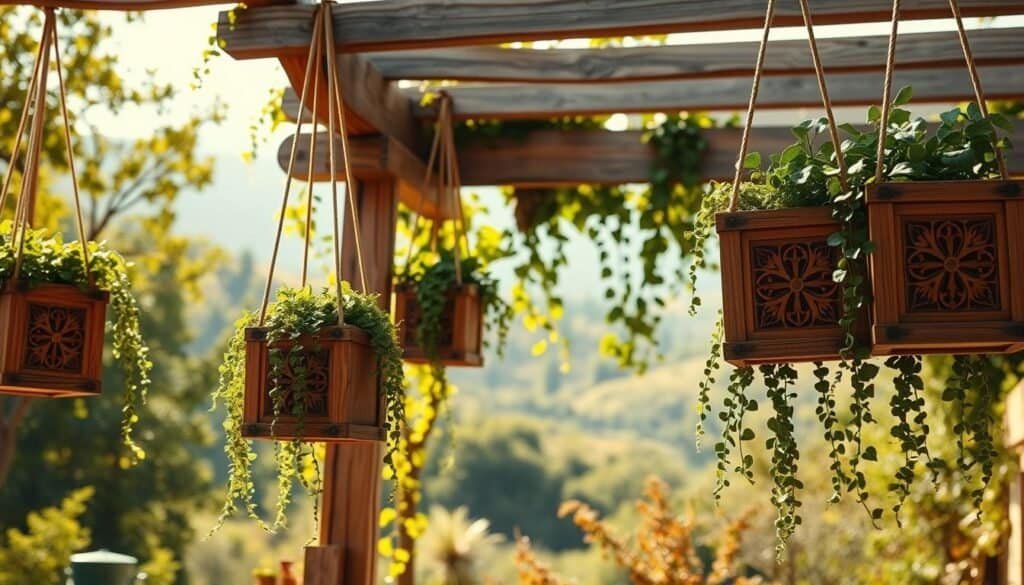
It’s important to hang your wooden planters safely to avoid accidents. Make sure the hooks or brackets are strong enough to hold the weight of the planters. Also, check the planters often to keep them securely in place.
Adding hanging wooden planters to your outdoor decor does more than just look good. It also adds depth and layers to your garden or patio. By picking the right plants and hanging them safely, you can have a stunning vertical garden. This will make your outdoor living space even more enjoyable.
Large-Scale Statement Planters for Dramatic Impact
Looking to make your outdoor space stand out? Large-scale statement planters are the answer. These big planters can turn any area into a beautiful focal point, catching everyone’s eye.
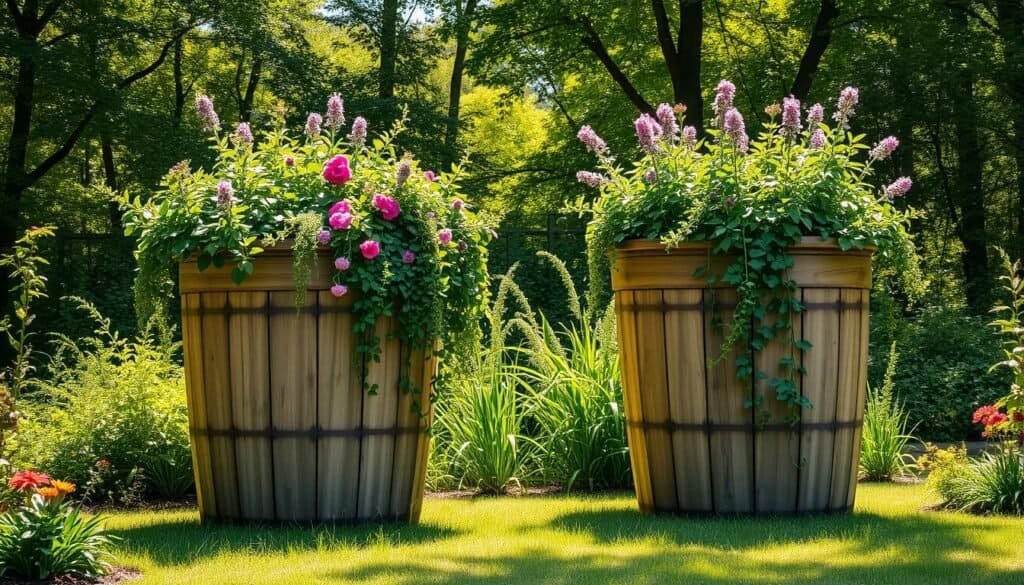
Choosing the right plants is key to making a big impact with these planters.
Architectural Plants for Height
For height, pick plants with interesting shapes, like tall grasses or dramatic shrubs. These plants stand out on their own or enhance other garden features.
Cascading Elements for Softness
To soften the look of big planters, add plants that cascade. Trailing vines or flowering plants that spill over the edges create a nice contrast.
When picking large-scale planters, think about the look you want. Do you want modern and sleek or rustic and natural? The right plants and planters can make your outdoor space look amazing.
By choosing the right planters and plants, you can make a big statement. Your outdoor decor will look better than ever.
Weatherproofing and Maintaining Your Wooden Planters
To keep your DIY wooden planters in good shape, it’s key to know about weatherproofing and upkeep. These planters face many environmental challenges like rain, sun, and extreme weather. These can wear them down over time.
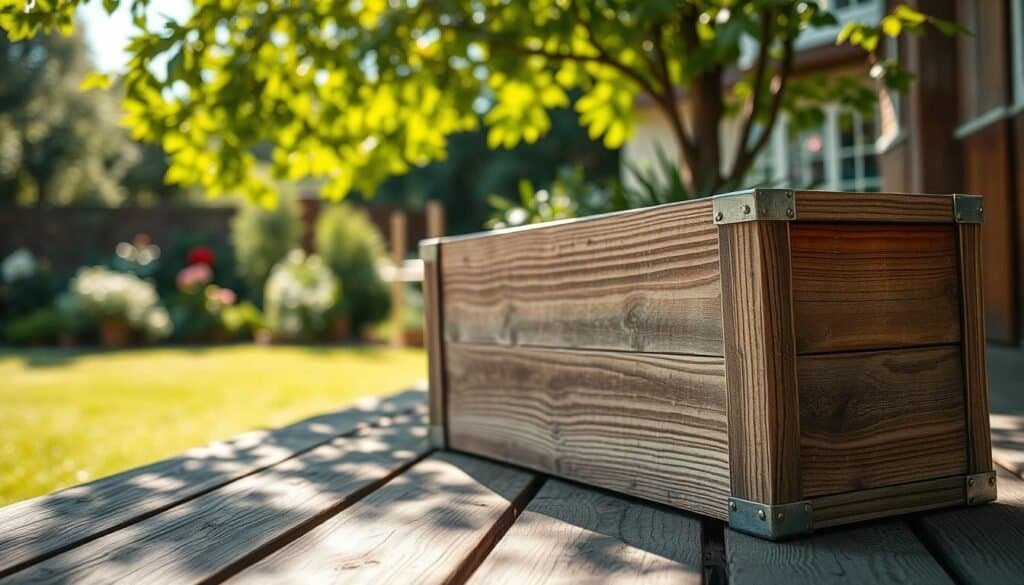
Weatherproofing means adding a protective layer to your planters. This helps keep the wood safe from moisture and UV rays. It’s also important to regularly check for damage and reapply finishes when needed.
Winter Protection Strategies
In winter, your wooden planters need extra care. They must handle cold weather and snow. One good way is to move them to a place that’s protected from harsh winds and freezing.
If moving isn’t possible, you can apply a thicker protective layer. Or, use a waterproof cover to keep snow and ice off.
Repair Techniques for Damaged Planters
Even with care, your wooden planters might get damaged. Issues like cracks, rot, and bugs can happen. For small cracks, you can use wood filler and then add a protective finish again.
But, for bigger problems like rot or big cracks, you might need to replace parts or even the whole planter.
Selecting the Right Plants for Your Wooden Planters
Choosing the right plants for your wooden planters can make your outdoor space more inviting. The type of plants you pick depends on the sunlight your planters get and your local climate.
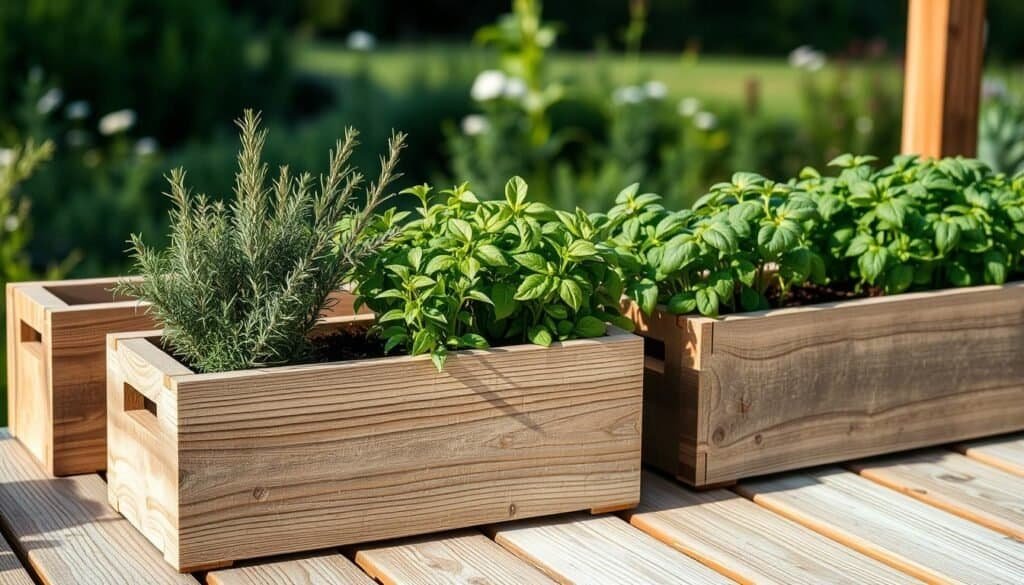
For a herb garden, basil, rosemary, and thyme are great picks. They smell good and are useful in cooking. Make sure the soil drains well to avoid waterlogged soil.
Herb Garden Arrangements
Creating an herb garden in your wooden planters is fun. Mix herbs with different textures and growth habits for a nice look. For example, pair tall rosemary with low-growing thyme for depth.
Vegetable Varieties Suitable for Containers
For vegetable varieties in containers, cherry tomatoes, leafy greens, and peppers are good. These plants do well in containers and can give you a lot of food. Make sure your planters have holes for drainage to avoid root rot.
By picking plants right for container gardening and your climate, you can have a lush garden in your wooden planters. Regular care, like watering and fertilizing, will help your garden thrive.
Conclusion: Transforming Your Outdoor Living with Handcrafted Wooden Planters
Making handcrafted wooden planters is a fun DIY project. It can change how you use your outdoor areas. Adding wooden planters brings natural beauty and elegance to your patio or garden.
In this article, we looked at different DIY wooden planter projects. We covered simple box planters to tiered and hanging ones. We also talked about the materials you need, basic woodworking skills, and how to keep your planters looking good.
Starting these DIY projects can make your outdoor spaces better. It also lets you enjoy making something yourself. So, start your next DIY project and see how handcrafted wooden planters can change your outdoor spaces.

